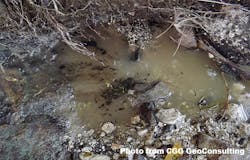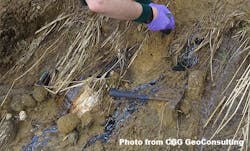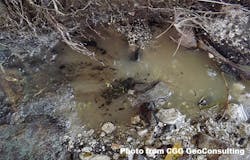Study finds onshore seeps in Jamaica, indicating possible active hydrocarbon system
The discovery of two onshore seeps indicates Jamaica may have an active hydrocarbon system for both oil and natural gas. The two onshore oil seeps were discovered about 70 km apart, marking the first recorded occurrences of liquid oil from mainland Jamaica.
The island nation is already known for its gas seeps, such as the Windsor gas seep in the St. Ann’s region on the island’s north coast. Petroleum Corp. of Jamaica (PCJ) and CGG GeoConsulting discovered the two onshore liquid oil seeps during fieldwork for a recently completed multiclient Robertson Study (Red Book) of Jamaica’s onshore and offshore petroleum. This follows the discovery of an offshore live oil seep, reported by Tullow Oil PLC in February 2017.
Subsequent geochemical analyses confirmed the seeps originated from two separate Cretaceous source rocks. CGG’s study comprises more than 1,300 new geochemical, biostratigraphic, and sedimentological analyses of more than 800 individual outcrop, well, corehole, and seep samples collected from Jamaica.
Underexplored frontier
Jamaica and its offshore basins are relatively underexplored, and 10 of 11 exploration wells drilled in the region have had oil or gas shows. According to CGG and PCJ, the discovery of the most recent seeps indicates the presence of working petroleum systems on the island that are generating and expelling liquid hydrocarbons to the surface.
The collaboration between CGG and PCJ is primarily for evaluating petroleum potential in Jamaica’s Mesozoic and Cenozoic sedimentary successions within the context of its new multiclient study. The month-long field campaign began on the island in October 2016, and prior to fieldwork CGG’s NPA Satellite Mapping group produced a new geological map of Jamaica at 1:100,000 scale, the first of its kind for over 40 years. The fully digital map was then “ground-truthed” in the field.
The map is important in distinguishing between fault blocks and carbonate terraces and also may provide evidence for the sense of slip of major fault zones.
Reinterpretation
New biostratigraphic, sedimentological, and geochemical analyses were performed on outcrop samples, together with core and ditch cutting samples from all available wells and 10 shallow coreholes from Jamaica provided by the PCJ.
Results enabled revision and updating of the sequence stratigraphic framework of Jamaica through the identification of several regional depositional sequences and unconformities. The distribution of these depositional sequences was extended into the offshore through interpretation of seismic data provided by the PCJ and a third party, with ties to the two Jamaican offshore wells—Arawak-1 and Pedro Bank-1—and nearby International Ocean Drilling Program sites.
The timings of the unconformities were attributed to global sea-level changes and regional tectonic events which were used in the creation of a revised tectonic model for the island. The new tectonic model together with interpretations of depositional settings from field data and biostratigraphic and sedimentological analyses were used to create palaeogeographic maps of Jamaica at key stratigraphic intervals relevant to the petroleum story.
Hydrocarbon shows
Researchers observed hydrocarbon shows in many of the Jamaican wells and coreholes. Geochemical analyses of the hydrocarbon shows and seeps were compared with the results of analyses from potential source rocks sampled from outcrop and subsurface samples, which confirmed the presence of three distinct groups of oils in Jamaica, however, only two seeps were discovered. Two of the oils are interpreted to have been generated from separate Cretaceous source rocks, with differing depositional ages and environments, and a further Cenozoic oil. The two Cretaceous oil groups encountered by the study are comparable to other oils recorded from the Caribbean region.
Contact Tayvis Dunnahoe at [email protected].


